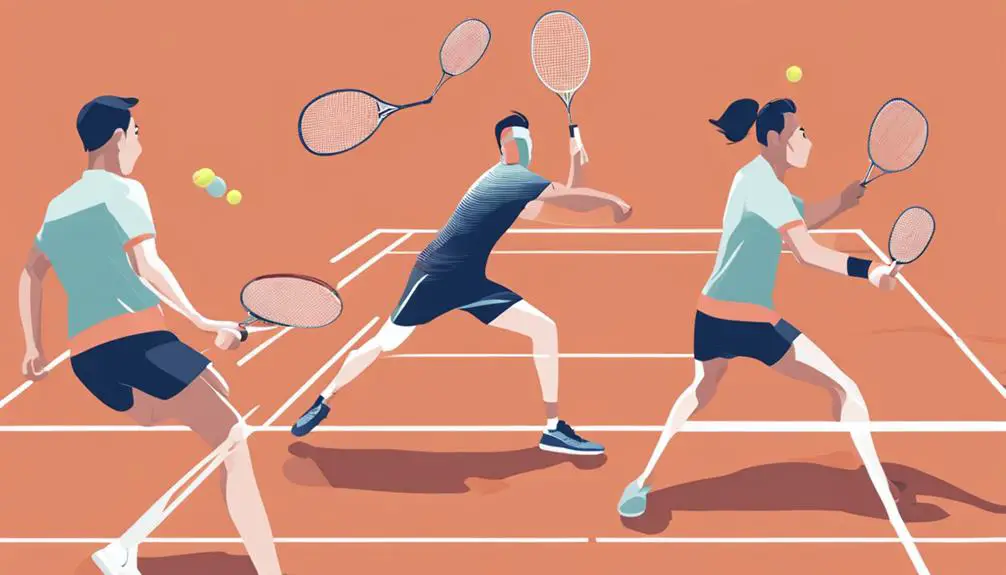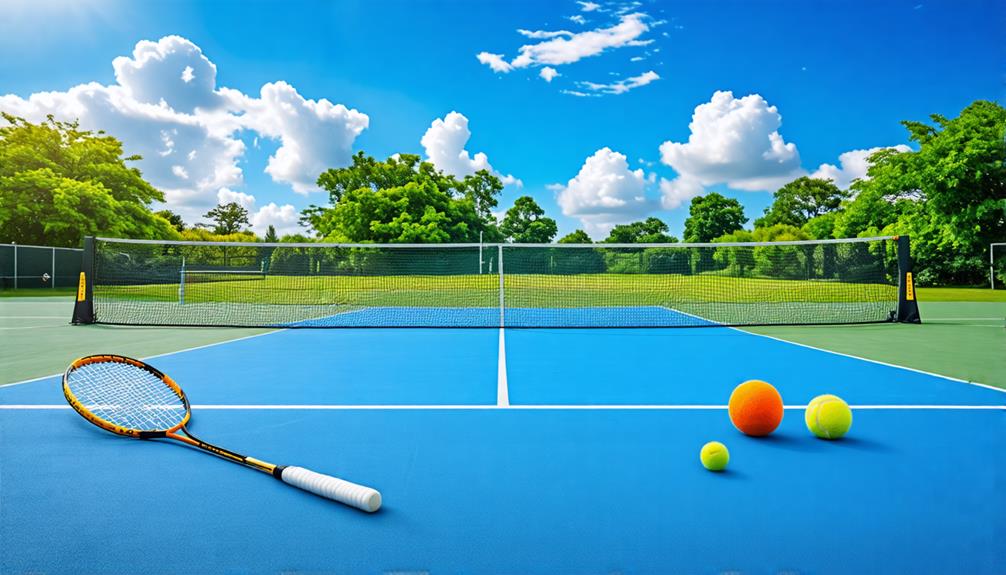You'll notice distinct differences between badminton and lawn tennis, despite their similarities as racquet sports. Court dimensions vary greatly, with badminton courts measuring 13.4m x 6.1m and tennis courts spanning 23.77m x 10.97m. Equipment requirements also differ, as badminton rackets weigh 70-90g and tennis rackets weigh 255-365g. The focus of each game diverges, with badminton emphasizing speed and agility, while tennis prioritizes power and endurance. As you explore the nuances of each sport, you'll discover how these differences impact gameplay, physical demands, and overall strategy, revealing a richer understanding of these two unique sports.
Key Differences Between Sports

How do the sports of badminton and lawn tennis differ regarding their fundamental characteristics? As you explore the world of racquet sports, you'll notice distinct differences between badminton and tennis. The court size is a notable disparity, with badminton courts being considerably smaller than tennis courts. This smaller court size lends itself to faster-paced gameplay, emphasizing quick reflexes and agility in badminton. In contrast, tennis courts are larger, requiring players to possess power and endurance to cover the greater distance.
The racket weight also differs considerably between the two sports. Badminton rackets are much lighter, weighing between 70 to 90 grams, whereas tennis rackets weigh between 255 to 365 grams. This lighter equipment allows for easier maneuverability in badminton, enabling players to respond quickly to the swift shuttlecock. Additionally, the scoring system and match length differ between the two sports. Badminton requires winning the best of three games to 21 points, resulting in relatively shorter matches. In contrast, tennis involves winning four points for a game, six games for a set, and typically two sets for a match, leading to longer match lengths. These differences contribute to distinct gameplay dynamics, with badminton emphasizing speed and agility, and tennis focusing on power and endurance.
Equipment and Court Comparison
Delving deeper into the nuances of badminton and lawn tennis, a comparison of their equipment and courts reveals considerable disparities that set the two sports apart. You'll notice that badminton rackets are substantially lighter, weighing between 70 to 100 grams, whereas tennis rackets tip the scales at 255 to 365 grams. This weight difference reflects the distinct dynamics of each sport, with badminton emphasizing agility and quick reflexes. Moreover, the strings of a badminton racket are tensioned to around 22 pounds, whereas tennis racket strings are tightened to between 50 to 60 pounds, impacting the play style and shot execution.
Examining the courts, you'll find that badminton courts measure 13.4 meters long and 6.1 meters wide for doubles, notably smaller than tennis courts, which span 23.77 meters long and 10.97 meters wide for doubles. The shuttlecock, designed to fly more slowly, requires precise control, while tennis balls are heavier and designed for high-speed play, necessitating more power in strokes. Additionally, the net height in badminton stands at 1.55 meters, which is lower than the tennis net height of 1.07 meters at the center, influencing the trajectory and style of play in each sport. These differences in equipment and court dimensions underscore the unique challenges and strategies inherent to each game, allowing players to develop specialized skills and techniques.
Physical Demands and Training

As you consider the physical demands of badminton and lawn tennis, you'll notice that both sports require distinct fitness and strength training regimens. You'll need to develop explosive power and agility for badminton, whereas tennis demands overall body strength, particularly in the legs, as well as endurance training for prolonged matches. Understanding the unique physical demands of each sport will help you tailor your training to meet the specific needs of your chosen game.
Fitness and Strength Training
The divergent physical demands of badminton and lawn tennis necessitate distinct approaches to fitness and strength training. You'll need to tailor your workouts to meet the specific requirements of each sport.
| Physical Demands | Badminton | Lawn Tennis |
|---|---|---|
| Primary Focus | Explosive power, agility, and quick reflexes | Aerobic endurance, muscular strength, and stamina |
| Training Methods | High-intensity drills, plyometric exercises for jumping ability and quick footwork | Longer runs, strength training for upper body power and endurance |
| Conditioning Goals | Enhance speed, reaction times, and sharpness | Build stamina, sustain longer matches, and develop muscular strength |
When training for badminton, you'll focus on building explosive power and agility through high-intensity drills and plyometric exercises. In contrast, lawn tennis requires a broader focus on aerobic endurance, muscular strength, and stamina. You'll engage in longer runs and strength training to develop your upper body and sustain longer matches. By understanding these distinct physical demands, you can create a tailored fitness and strength training program that optimizes your performance in either sport.
Endurance and Stamina Needs
Badminton and lawn tennis diverge greatly when it comes to endurance and stamina needs, mirroring the distinct physical demands of each sport. You'll find that badminton matches are generally shorter, lasting between 30 to 45 minutes, with the longest recorded match being 2 hours and 41 minutes. In contrast, tennis matches typically last around 90 minutes and can extend for hours in professional play.
The physical demands of each sport are also reflected in the calories burned per hour. Competitive badminton players can burn up to 600 calories per hour, while casual players burn about 300 calories per hour. Meanwhile, competitive tennis players can burn up to 775 calories per hour. Key differences in endurance and stamina needs include:
- Badminton requires quick bursts of energy and rapid movements
- Tennis demands sustained energy levels and prolonged periods of activity
- Badminton training focuses on agility and explosive power
- Tennis training emphasizes overall body strength, particularly in the legs for lateral movement
Understanding these differences is essential for tailoring your training and preparation to meet the specific endurance and stamina needs of your chosen sport.
Scoring Systems and Gameplay
Racquet sports enthusiasts often find themselves drawn to the distinct scoring systems and gameplay of badminton and lawn tennis. You'll notice that badminton games are played in a best-of-three format, with each game going up to 21 points. In contrast, tennis matches require winning four points to take a game, six games to win a set, and two sets to win the match.
A key difference between badminton and tennis lies in their scoring systems. In badminton, you score points on every rally, regardless of who served. This is known as rally point scoring, which leads to faster-paced matches. On the other hand, tennis only allows the serving player to score points until they lose their serve. This difference greatly impacts the dynamics of each game.
Badminton games have shorter intervals, with a two-minute break between games and a 60-second break when a player reaches 11 points. In tennis, you'll see changeovers and longer breaks between sets. The gameplay also differs regarding what constitutes a valid rally. In badminton, the shuttlecock must clear the net and land within the designated court area. In tennis, the ball must bounce within the opponent's court to remain in play. These differences contribute to distinct active playtimes, with badminton matches generally being shorter than tennis matches. Understanding these differences is essential for players and spectators alike, as it influences strategy and overall gameplay.
Speed and Dynamics Analysis

You're about to witness a significant disparity in speed between badminton and lawn tennis, as the former is recognized as the fastest racquet sport, with shuttlecock speeds reaching an astonishing 493 km/h, far surpassing the fastest recorded tennis serve at 263 km/h. As you analyze the dynamics of play, you'll notice that badminton requires rapid stop-and-start movements, whereas tennis emphasizes sustained lateral and forward movement across a larger court. This contrast in speed and dynamics stems from the distinct equipment and court sizes used in each sport, setting the stage for a unique comparison of their respective demands on players.
Fastest Racquet Sport
One of the most striking aspects of badminton is the sheer velocity at which the shuttlecock travels, with recorded speeds reaching an astonishing 493 km/h (306 mph) during a match – a feat that solidifies its position as the fastest racquet sport. As you explore the dynamics of play, you'll notice that badminton players engage in quick, explosive movements and rapid changes of direction, allowing them to react swiftly to the fast-moving shuttlecock. This is in contrast to tennis, where powerful strokes are often employed across a larger court size.
The speed dynamics in badminton lead to intense rallies, with players often engaging in quick exchanges that require exceptional reflexes and hand-eye coordination. Here are some key aspects that contribute to badminton's fast-paced nature:
- Explosive movements: Badminton players need to be agile and quick to cover the court.
- Rapid changes of direction: The shuttlecock's unpredictable trajectory demands swift reactions.
- Lightweight shuttlecock: The shuttlecock's low weight allows it to travel faster and change direction rapidly.
- Smaller court dimensions: The compact court size enables players to quickly move around and respond to shots.
Speed Comparison Analysis
Badminton's distinction as the fastest racquet sport is underscored by its significant speed advantage over lawn tennis. You'll find that the fastest recorded badminton shot reaches 493 km/h (306 mph), far outpacing the fastest tennis serve at 263 km/h (163 mph). This discrepancy is largely due to the difference in mass between badminton shuttlecocks and tennis balls. The badminton birdie, being lighter, can achieve higher speeds with less force.
The dynamics of badminton play involve rapid acceleration and deceleration, resulting in quick exchanges, whereas tennis tends to have longer rallies with more sustained movement. As a player, you'll need to exhibit exceptional agility and reflexes to respond to the fast-moving shuttlecock, contrasting with tennis players who rely more on powerful strokes and strategic placement. The speed of play in badminton is often more intense, with players engaging in quick directional changes and short bursts of energy. This demanding nature of badminton sets it apart from tennis, requiring a unique combination of speed, agility, and endurance.
Dynamics of Play
While the speed of the shuttlecock is a significant factor in badminton's dynamics of play, it is the rapid acceleration and deceleration that truly set the sport apart from lawn tennis. As you investigate the world of badminton, you'll notice that the rapid stop-start movements and quick direction changes require exceptional agility and reflexes. In contrast, tennis emphasizes continuous lateral movement across a larger court, demanding strength and endurance for powerful serves and groundstrokes over longer distances.
Here are some key differences in the dynamics of play between badminton and tennis:
- Rapid acceleration and deceleration in badminton versus continuous lateral movement in tennis
- Shorter average rally length in badminton due to the lighter shuttlecock and quicker pace of play
- More downtime between points in tennis, averaging about 17.5% active play, compared to badminton's 30-50% active play
- Greater emphasis on agility in badminton versus endurance in tennis
As you explore the dynamics of play in both sports, you'll appreciate the unique demands of each game. Badminton's fast-paced, high-intensity rallies require quick thinking and rapid movements, while tennis demands sustained energy and powerful strokes over a longer period.
Financial and Community Aspects
Tennis's lucrative nature is evident in the substantial disparity in prize money between the two sports. As you consider the financial aspects of badminton and lawn tennis, you'll notice that tennis players have a notable edge. The Wimbledon singles winner, for instance, earns around £2,350,000, while the Badminton World Championships singles winner takes home approximately $125,000. This disparity is largely due to tennis's global popularity, which attracts more sponsorship and endorsement opportunities.
The lack of financial support and sponsorship in badminton has limited the growth and professional opportunities available to players. In contrast, tennis players can rely on their sport for income, thanks to considerable financial incentives from prize money, sponsorship, and media exposure. You'll find that professional badminton players often face challenges in securing financial stability, leading to a reliance on secondary careers or sponsorships.
The community aspect also differs remarkably between the two sports. Tennis has a more established fanbase and extensive media coverage, whereas badminton's community, although passionate, is still growing. The badminton community emphasizes inclusivity and a shared love for racquet sports, but it lags behind tennis regarding professional opportunities and financial stability. As you weigh the pros and cons of each sport, consider the impact of financial and community aspects on your freedom to pursue a career in either badminton or lawn tennis. Ultimately, tennis offers more financial security and professional opportunities, but badminton's community-driven approach may appeal to those who value camaraderie and shared passion.
Frequently Asked Questions
Is Lawn Tennis Harder Than Badminton?
You're wondering which sport is harder, and the answer lies in various factors. Considering skill levels, court dimensions, and equipment differences, each sport has unique physical demands. Lawn tennis requires sustained energy over a larger court, while badminton demands quick bursts of speed and agility. Game strategies and player endurance also play a role. Ultimately, the difficulty of each sport depends on your individual strengths and skills, making it a subjective assessment.
What Is the Difference Between Lawn Tennis and Badminton?
You're probably wondering what sets these two sports apart. Let's explore. The court dimensions differ considerably, with one being much larger than the other. Equipment differences are also notable, from the weight of the balls to the rackets. Scoring systems vary, with one requiring four points to win a game and the other played to 21 points. You'll also notice distinct player movements and game origins, influencing their popularity levels worldwide.
Is Badminton Healthier Than Tennis?
You're about to plunge into a debate that's been raging like a thousand burning suns – which sport reigns supreme in the health department? When it comes to cardiovascular benefits, muscle engagement, and calorie burn, both sports are excellent. However, badminton's lower joint impact and higher mental focus requirements might give it a slight edge. Meanwhile, tennis's prolonged matches may boost aerobic endurance, but also increase injury risk. It's a tough call, but ultimately, both sports can be incredibly beneficial for your overall health.
Which Is Faster, Tennis or Badminton?
You're wondering which sport reigns supreme regarding speed. When examining shuttle speed, racket techniques, and player agility, it's clear that one sport demands lightning-quick reflexes. Court dimensions and scoring systems also play an essential role in determining the pace of play. Through historical evolution, one sport has honed its speed, requiring swift movements and rapid-fire shots. Considering these factors, you'll find that badminton's blistering pace outstrips its counterpart.




